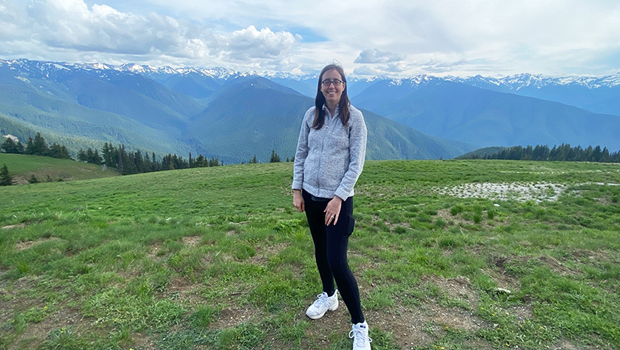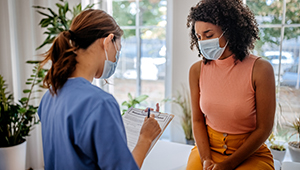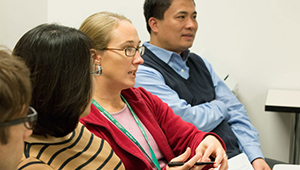How Jennifer Bobb solves statistical problems to improve health care

Her expertise helps improve outcomes for people with substance use disorders
Jennifer Bobb, PhD, associate biostatistics investigator at Kaiser Permanente Washington Health Research Institute (KPWHRI), recently received an Emerging Leader Award from the Committee of Presidents of Statistical Societies. The award recognized her significant contributions to the field of environmental biostatistics, her research that advances the field to improve outcomes for people with substance use disorders, and her outstanding service to the profession of biostatistics.
At KPWHRI, she collaborates with investigators on a broad range of research topics and provides statistical leadership and guidance for pragmatic clinical trials, large observational and comparative effectiveness studies, and other clinical and epidemiological studies. In partnership with Fred Hutchinson Cancer Center, she serves as a mentor for undergraduate students from backgrounds that are underrepresented in the biomedical sciences.
How did you get started in your field?
I always liked math, but because I was hoping to do something practical for my career, I initially chose an engineering major in college. But engineering required so many core courses that I felt that I was missing out on a liberal college education, including the ability to take fun electives, and so I decided to switch to a math major.
In the summer during college, I participated in 2 programs that were focused on abstract math research, which were fun, but I struggled with the lack of immediate impact of the work. I feel very fortunate that a family friend in Pittsburgh, who knew me and thought I would be interested in biostatistics, encouraged me to get a summer job to get some experience with the field. The job mostly involved data management rather than statistics, but it gave me a sense of what it would be like to work as a statistician in a research environment.
This experience inspired me to apply to a range of graduate programs in statistics and biostatistics, and I ended up going to a PhD program in biostatistics at Johns Hopkins. Through my applied statistics research in the field of environmental health, I could see how biostatistics could be used to inform environmental policy to improve population health, which inspired me in my career to develop statistical methods that solve real-world problems.
What are your research interests?
My general interest is in developing statistical methodology that is directly contributing to solving public health problems, making studies more rigorous, and ultimately influencing public health policy.
When I was doing my graduate and postdoctoral work, I was primarily focused on environmental health — including statistical methods to estimate the impact of heat waves and air pollution on people’s health. At KPWHRI, I’ve worked on a lot of studies of health system interventions to improve care for people who have challenges with alcohol and substance use. Because many of these studies use electronic health record (EHR) data, which was not originally collected for research purposes, there are many interesting statistical issues that arise, which often need new statistical methods. I’ve gotten really interested in pragmatic trials, to try to understand the opportunities and challenges of using EHR data for randomized studies that can produce the most impactful research.
What are some current projects you’re excited about?
I’m very excited by my work on the MI-CARE trial led by Kathy Bradley and Lynn DeBar. This study includes patients that have both opioid use disorder and depression and is examining a nurse care manager intervention to work with patients to address these or other health issues in a way that engages the patient in care.
It’s an interesting study methodologically for a few reasons. We’re using a Zelen design, which allows us to look at patient engagement in the trial. With a more standard clinical trial design, you first get consent from patients who are interested in participating and then you randomize them. The problem is that you tend to get patients who are already the most engaged and maybe the most motivated. So, it’s hard to address the question of how you increase engagement among patients. In our design, we first identify eligible patients using EHR data, and then we randomly assign half to be offered the intervention.
We are using secondary EHR data sources for this study, which introduces challenges — for example, that patient screening data reported in the EHR are irregularly spaced and could be impacted by the intervention that our study is testing. Another major challenge is that our study is trying to link our trial cohort with prescription monitoring program data, which provides complete information on buprenorphine prescriptions — one of the main sources of treatment for opioid use disorder. Statistically, that’s interesting because we’ve never used this data source for research.
I’m also in the process of analyzing data for the DIGITS trial, led by Joe Glass. This study evaluated different ways of implementing a digital therapeutic (a smart phone-based app) that’s approved for treating substance use disorders. Abisola Idu was the collaborative biostatistician on that trial who I partnered with to plan the trial analyses. It’s exciting to be in the analytic phase of that trial and be at the stage where you start to see results. Primary care clinics were randomized to 4 different groups, that either have practice facilitation or not, and health coaching or not, and we’re looking at how these interventions could increase reach and adoption and improve patient outcomes using this app.
Why is KPWHRI a unique place for your work?
I think the opportunity to work closely with people across different scientific areas is unique, especially the proximity that we get to have to each other.
When we were in the office regularly, for example, my primary scientific collaborator was next door to me. Our biostatistics division gets to interact and learn about what people are working on and collaborate with scientists from a range of different backgrounds — including physicians, epidemiologists, and health services researchers — as part of the same research department, whereas in traditional statistics or biostatistics departments situated in university settings, you would commonly be looking for scientific collaborators outside your department. That was one of the things I really liked when I was thinking about coming to KPWHRI. I was also inspired by how our biostatistics investigators are leaders in national research networks, like the Vaccine Safety Datalink and the Mental Health Research Network, and have a broad impact for improving methods in generating real-world evidence.
What do you like to do outside of work?
Most of my spare time is spent with my family. I have 3 daughters, so we spend a lot of time just hanging out, going to parks or museums, and doing other activities around Seattle. This winter was really fun because we took the older 2 skiing where they did lessons at Snoqualmie. I love to be outside, just going for walks around the neighborhood, and I enjoy hiking. I’ve never gone backpacking, and that’s a bucket list thing for me, so my sister and I are planning a trip this summer. I also enjoy doing puzzles and having boardgame nights, and traveling to visit family in Chicago, Pittsburgh, New York, and Florida.
Research

Better care for patients who drink alcohol
A new primary care approach improves alcohol-related preventive care as well as care for alcohol use disorder.
Vaccine Safety

Biostatisticians track COVID-19 vaccine safety
Dr. Jennifer Nelson explains how KP scientists are helping the CDC and FDA keep an eye out for rare adverse events.
Research

HEAL responds to double crisis: Opioids and COVID-19
Health care is increasingly online—KPWHRI is studying telehealth options for opioid use disorder and chronic pain.


